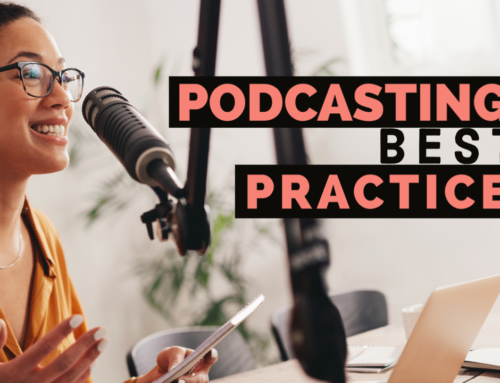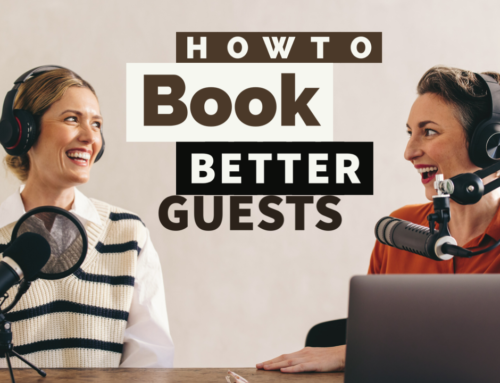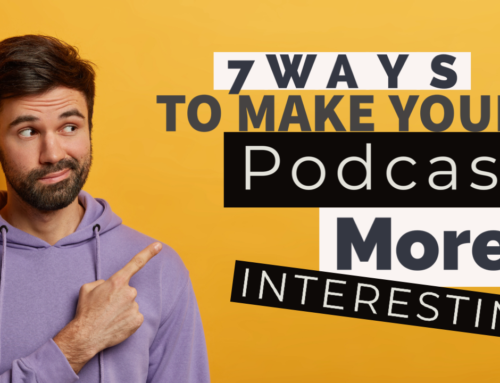5 Mistakes to Avoid When Adding Video to Your Podcast
Looking to turn your podcast into a video podcast? Great! Just make sure to avoid these 5 basic mistakes.
More and more podcasters are turning their audio shows into video shows. Roughly 20% of active podcasts today are now also video podcasts. This isn’t surprising, as adding video to your audio podcast is a fantastic way to communicate and boost your reach as a content creator. It allows your audience to match a face to the voice and encourages a deeper and more personal connection compared to audio alone.
However, certain bad habits and poor practices can quickly sabotage your video podcasting efforts and make your audience quickly disappear. Or worse, fail to grow in the first place!
Let’s discuss 5 basic mistakes to avoid before you hit Record.
#1 Poorly Framed Shots
When setting up your video recording, your frame should include your face, shoulders, and down to your hands if possible.
A poorly framed shot may show unflattering angles, too much or too little of your body, or not enough headroom. These things can be highly distracting to viewers, so work towards getting yourself positioned well in the frame – even if you must use the zoom function on your camera. Get creative and adjust until you find a good angle that works for both you and your audience.
Don’t depend solely on your post-production team to make a poorly framed video look amazing.
Some things can be fixed or improved, but there is only so much that can be done with what is actually in the frame. Have the end results in mind when you are setting up your frame. The close you can get it to your final vision, the better your video is going to look in the end.


#2 Distracting Backgrounds
Another simple, yet common mistake to avoid is having a distracting or busy background. The colors and patterns within your filming environment should not blend with your clothes or divert the viewers’ attention.
Keep your background simple and uncluttered so your audience can focus on your message.
If you’re in an office or conference room, make sure there are no distracting visuals, people walking by, unrelated writing, or posters on the walls behind you. If you’re outside, find a quiet spot where there won’t be many people walking by or passing cars.
Pro Tip: Keep in mind audio considerations if recording outside. It’s probably a good idea to talk to an audio professional beforehand, so they can direct you on how to be successful.
Beware of overly saturated and intense colors in the recording environment
Beyond avoiding distracting backgrounds, be sure to limit overly saturated colors behind or even around the recording area. Too much color can reflect badly and make it difficult to focus on what’s happening in the video.
If you are showing a computer screen, be sure the computer is free of clutter.
There should be no extra windows open or other things happening behind your computer. Dim your monitor or even use dark mode on any apps that you plan to show from your computer. Plain white backgrounds can be harsh on the eyes when picked up through a camera.
#3 Underestimating Good Lighting
Three-point lighting is an easy way to eliminate bad shadows and create distance between the subject and the background.
Three-point lighting typically involves a key light, which is the main source of light. A back light that goes behind the subject and typically is directed above them. And a fill light, which usually comes more from the side, and is used to soften shadows, particularly on faces.
Ditch the fluorescent lights.
These lights have a distinct tint and can make anybody’s skin look unnatural, washed out, and tired. It can also be unflattering and is a good way to make drag down your production quality.
# 4 Settling for Poor Audio Quality
If you are just starting your podcast journey, you may think that it’s just fine to use the built-in computer microphone for recording your voice. But understand that the poor audio quality generated by built-in mics is one of the biggest turnoffs for potential listeners. If you have access to a better microphone, use it! A good quality mic will make all the difference when it comes to your audience being able to hear and understand what you’re saying.

Invest in a dependable microphone and audio setup.
This is very important! If your audience cannot hear what you’re trying to say, they will simply quit listening, and you cannot afford to lose those listeners. If you can’t purchase a quality microphone right away, an affordable USB microphone can still be a solid option for starting out.
Beyond your microphone situation, some other elements to watch for are excessive background noise, fidgeting with objects, unpleasant mouth smacks, and those dreaded filler words, which can make it difficult for your audience to follow what you’re saying. If kept to a bare minimum, you will do just fine by letting these slip from time to time. However, understand that whenever you have guests on, these will be largely out of your control. Ultimately, the surest option to eliminate all of these concerns is to give your podcast a time-synced audio-only edit as well, which we pride ourselves on here at The Post Production Shop.
Do (at least) a basic level of mixing and mastering.
It’s definitely possible to do this on your own if you have the time and inclination to watch a few videos and purchase some software. But if you come to us for your audio editing needs, we will always mix and master for you, so you won’t need to worry about it.

# 5 Blocking Your Face with the Microphone
Hopefully, you took the advice from step #4 and went and bought a quality microphone. Congratulations! You’re one step closer to developing the ultimate podcasting setup. But now that you have that microphone, it’s worth mentioning that you don’t want to be positioning the mic in between you and the camera so that it’s blocking your face.
Microphones can be chunky and awkward sometimes. Pop filters are big too, so it can be difficult to get a good video angle while talking into a microphone. We get it, but your audience won’t.
People want to see your face, so frame your video so that the mic is not completely blocking it.
You may have to get creative or get a microphone stand that works specifically for your filming setup. The microphone should be placed 4-6 inches away from your mouth when speaking, so keep this in mind when deciding where to station your mic and your camera.
The best way to prevent this common issue is to just position your microphone to one side of your face. Provided that you have a quality mic, you’re in a relatively noise-free environment, you aren’t fidgeting with objects, and ideally, you’re investing in having your audio professionally edited as well, then you have nothing to worry about. You will hardly notice at all the difference in audio quality at the side of your face, as opposed to directly in front of it. Nevertheless, there’s surely a happy medium to be found for you regarding microphone placement, given these considerations.

Ending Words
Of course, there are lots of things that can go wrong when you’re doing a video podcast yourself — it’s hard to get the lighting right, and you might have trouble getting everyone framed as well as you’d like. It’s difficult to keep everyone quiet during filming. And who knows what kind of sound quality you’ll end up with?
That’s where we come in: we’re a company that specializes in podcast audio/video production services. We’ve been helping podcasters create high-quality content for years now, so we know exactly how to help you make your voice heard in the best way possible. Contact us today to have us take care of your next podcast episode at The Post Production Shop.




